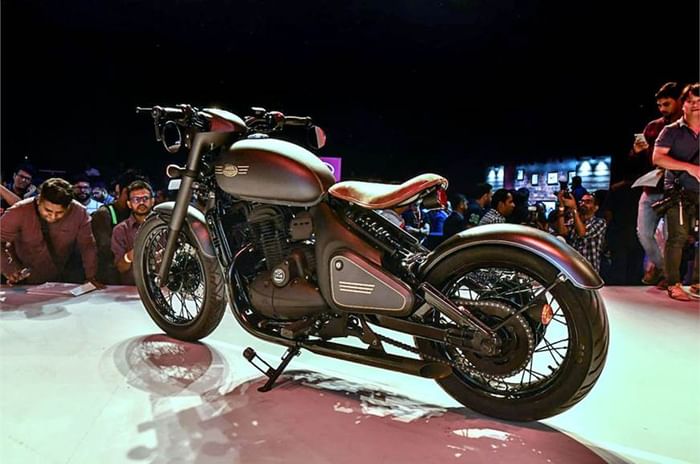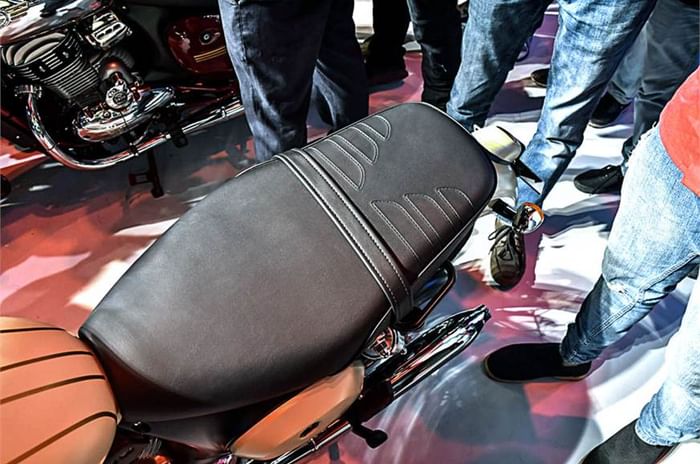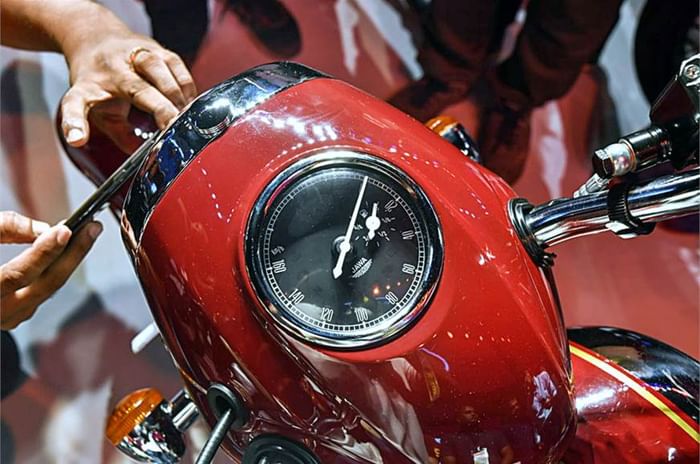Impressed with what you’ve seen so far? So are we! The extent to which Jawa (or Classic Legends, if you prefer) has painstakingly recreated the visual magic of the original Jawa motorcycles is deserving of a hat-tip and a round of applause, at the very least. But is that itself going to be enough to make the all-new Jawa bikes a runaway success? Let’s take an in-depth look at what exactly the new Jawas entail.
3 models, 2 engines, no variants
A good call, certainly, was to resurrect Jawa in India with more than just one motorcycle. While ‘a Jawa for everyone’ might have been a big ask, it’s a wise decision to broaden the originally-Czech brand’s appeal, taking it beyond purely retro. Proof of this is in the two models that flank the standard Jawa – the Forty Two and the Perak.
The Forty Two is the cheapest Jawa on sale in India right now, priced at Rs 1.55 lakh (ex-showroom, Delhi). While it’s mechanically identical to the standard Jawa (it’s called, simply, the Jawa), it sports a few differences in terms of trim and colours. The Forty Two features a short front fender with tubular metal brackets, a cowl-less headlight dome, an offset single-pod speedometer with a tiny integrated digital display, a flatter handlebar, ‘bar-end mirrors, a single-colour tank, blacked-out fork cover and partially black cylinder fins. The headlight also sits lower, with the registration plate mounted right below; on the regular Jawa, the horn with a chrome embellishment slots in between the headlight and the registration plate, which replicates the front-end styling of the original Jawas.
The standard Jawa features the gorgeous headlight/instrument pod cowl, which is more or less an exact replica of the one seen on the original Jawas. The speedometer is bigger on it and it also features an analogue fuel gauge and a small digital display for an odo (and hopefully trip meters). The handlebar grips are also classic-styled, with a prominent bulge in the centre – a neat touch. A tubular metal grab rail is also featured on both, the Jawa and the Forty Two, and it’s compact and neatly integrated. The Jawa’s front fender is a full-length, more traditionally-styled (and mounted) unit that is immensely pleasing to the eye. Its engine features silver paint in prominence with tasteful black accents. Lastly, the sides of the 14-litre fuel tank are chromed, which establishes an instant connection with the yesteryear Jawas.

The Perak is a bobber-styled motorcycle and is pegged as a factory custom. It features a 334cc motor, which is a revised, more powerful version of the 293cc, liquid-cooled, DOHC motor seen on the Jawa and the Forty Two. With 30hp and 31Nm of torque, the Perak should offer stronger performance than the other two Jawas. It features a revised chassis configuration as well, particularly at the rear end; here, the Perak gains a neatly tucked-in monoshock, a feature that is absent on the other Jawas that, instead, employ a twin shock absorber setup. The Perak is also the only new Jawa to feature a rear disc brake and the bike we examined from close quarters also featured an ABS ring at the rear, confirming the presence of a dual-channel ABS setup. While the price tag for the Perak has been disclosed – Rs 1.89 lakh (ex-showroom, Delhi) – the motorcycle will only go on sale in the second-half of 2019.
Interestingly, all the Jawas are available in a single spec, which means making a choice becomes an uncomplicated process.
Keeping it simple – specifications
The Jawas aren’t over the top in terms of engine specifications, but the impression we gather from the spec sheet (without having ridden the bike, of course) is of spirited performance. The all-new 293cc motor is BS-VI compliant, making it the first of its kind to go on sale in India, and it features fuel-injection, liquid-cooling and DOHC. At the moment, the rpm figures at which peak power (27hp) and torque (28Nm) are produced haven’t been revealed to us. The motor is paired to a 6-speed gearbox and a great highlight, visually at the very least, is the twin-port layout that ends in the two unmistakeably Jawa-styled chrome exhaust pipes. Unfortunately for purists, a kick-starter has been done away with, so there’s no lovably quirky combined kick-lever/gearshifter to fire it up – an electric starter will have to do.
On the whole, the Jawa’s specifications impress, but they aren’t anything that will keep you up at night, except if you compare them to the Royal Enfield Classic 350 (which we will, further into this story).

Comfort and usability
We did get the opportunity to size the new Jawas up and they come across as fairly city-friendly. While presence is not discounted, the Jawas aren’t particularly imposing in terms of dimensions. The low 765mm seat height will definitely find fans among shorter riders and of universal appeal will be its friendly 170kg kerb weight (the same as an RC 390). Ground clearance hasn’t been revealed yet, although Classic Legends tells us that these bikes will comfortably ride down a flight of stairs, just like the originals could.
Moving on to comfort, the Jawa and the Forty Two feature a conventional telescopic fork (with concealed fork tubes, just like on the original) and twin shock absorbers with gas canisters. This is a fairly standard setup and, with a 18-/17-inch (front/rear) wheel combination, you can expect a nimble handling package. The single-piece seat is amply wide for the rider, although it instantly came across as soft and not too generously padded – definitely something of a concern over a long riding day, although it does the aesthetics a load of good. Loaded up with two fully grown adults, we did note that there isn’t much space for the pillion and it has a mild rearward slant, which can be bothersome under hard acceleration. The only apt fix we can think of is a back rest, and we hope Jawa will offer an accessory by the time the bikes are ready for deliveries.

Among other details, the ignition key slot is positioned towards the right of the fuel tank – inconvenient, but it does keep the rider’s point-of-view clean and aesthetically pleasing. What’s not nice is the separate handlebar lock, mounted on the frame – an integrated, single-key unit is just far more convenient, especially in low-light conditions. We also spotted an elaborate and fairly flush-fitting under-engine sump guard that starts from where the radiator (also a neatly designed unit) ends. Missing from the bikes on display were crash guards and saree guards, but those tend to gel decently with retro-styled motorcycles, so it’s not something you should be worried about. The rubber-topped foot pegs look nice as well, and it’s good to see that the rider pegs are sprung units. The chromed brake pedal and gear lever (on the standard Jawa) also do the needful in terms of delivering classic styling.
On the whole, the Jawas boast good levels of fit and finish as well. The paint quality and chrome is certainly impressive and we couldn’t find any unpleasant welds or exposed cables and connectors, which shows an encouraging level of attention to detail. However, a closer inspection revealed that the rear indicators were slightly misaligned and we’d like to see this cleaned up.
The ‘Classic’ factor
This bit is a crucial one, given that the Royal Enfield Classic 350 has ruled the roost for the last nine years – since its launch in November 2009, that is. The Classic 350 spearheaded Royal Enfield’s revival and, given the phenomenal business it drew in, deserves credit for enabling the brand to make its mark on the world motorcycling map. It can be said that there wouldn’t be a Jawa in India today had there not been the tremendous market potential identified (and basked in, of course) by Royal Enfield and the Classic 350.
Jawa Motorcycles is only too aware of this and, on paper at least, it appears to have done its homework to perfection. With 27hp on offer, the standard Jawa and the Forty Two have a 7hp lead on the Classic 350 (20.7hp), although torque, at 28Nm, is evenly matched between the bikes. If the 7hp advantage isn’t enough, you must also consider that the Jawa, at 170kg, is 22kg lighter than the 192kg Classic 350. While we are yet to ride the bike, it doesn’t take a genius to figure out the performance edge it’s going to boast over the Classic 350. The Jawa’s is clearly the more sophisticated and better-equipped motor, too, with liquid-cooling, fuel-injection and, of course, BS-VI compliance in place. Another definite advantage will be the Jawa’s highway cruising ability, given that it features a 6-speed gearbox – that’s one more cog than the RE offers. The presence of a 6th gear should help it attain good highway fuel-efficiency figures despite its higher power output over the Classic.
What did get our collective eyebrows raised was the unusually high compression ratio – 11:1 – which is noticeably higher than on the Royal Enfield Classic 350 (8.5:1) and goes into KTM 200 Duke (11.3:1) territory. This hints at plausibly higher heating characteristics, especially in crawling city traffic but we will, of course, reserve our final verdict on this until we’ve ridden the motorcycle in said conditions.

The timeline
Jawa has currently appointed 105 dealers across the country, of which 64 are being readied for a December opening. Display and test-ride motorcycles will make it to dealerships at this time, and Jawa Motorcycles has promised commencement of deliveries of the Forty Two and the Jawa within the first quarter of 2019 – we expect it to begin in January rather than March. The Perak, we have learned, will go on sale roughly five months after the first of the Jawas have been delivered. Jawa is said to be working on an accessory pillion seat as well, given the limitations of a single-seat-only motorcycle, and it will be interesting to see how this is integrated.




































